1lumen selects and reviews products personally. We may earn affiliate commissions through our links, which help support our testing.
Nebo 12K flashlight review:
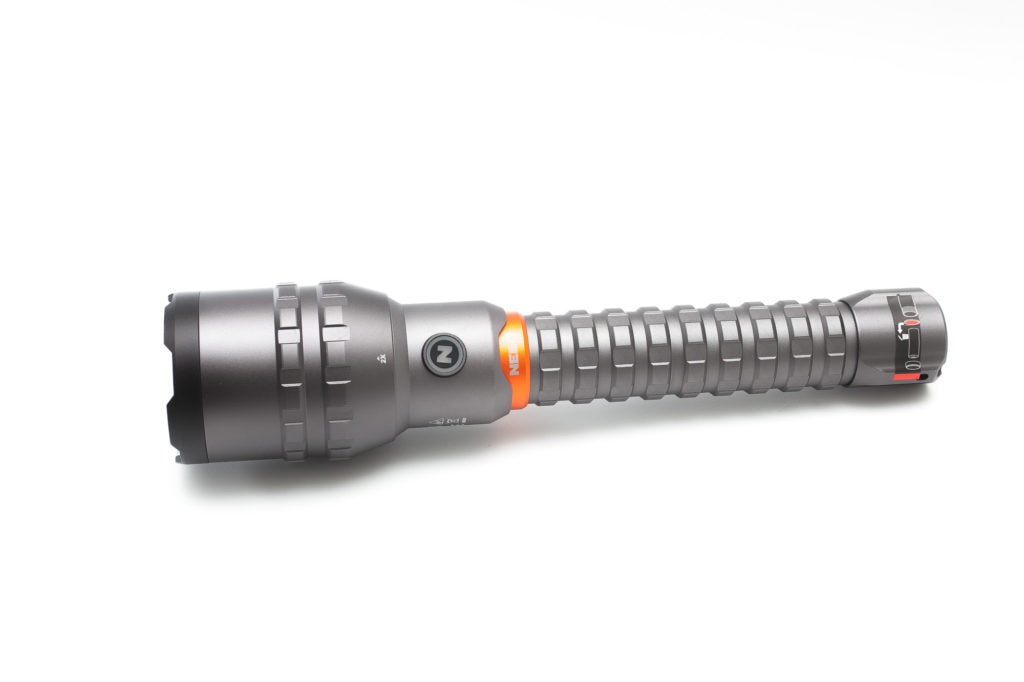
Nebo 12K flashlight specifications
| Brand/model | Nebo 12K |
|---|---|
| LED | COB |
| Max. Lumens | 12,000 lm |
| Max. Beam intensity / distance | 220 meters (about 12,000 cd) |
| Battery config. | Battery pack (2*26650) |
| Onboard charging | USB-C (power bank) |
| Modes | 4 |
| Blinkies | Strobe |
| Reflector | Convex lens |
| Waterproof | IP67 |
| Review date | April 2022 |
Introduction:
Nebo has been a well-established brand in the flashlight world for over 20 years. And even though they don’t cater much to flashlight enthusiasts, they have a few very interesting flashlights in their lineup. One of them is the Nebo 12K, a powerful flashlight with a claimed output of 12,000 lumens. And just like with every other review, we test to see if those claims are trustworthy.
So, if you’re looking for a lumenmonster that you can buy in many shops across the globe, this review might be for you.
Package quality.
It’s great to see that the packaging is of high quality, as you would expect for the price. It’s a strong cardboard box with padding to keep the flashlight in place. And this is what’s inside the box:
- The flashlight: Nebo 12K
- Lanyard
- USB-C charging cable
- Battery pack (2*26650 batteries with 5,000 mAh capacity)
- Short manual
Here’s a Nebo unboxing video I took
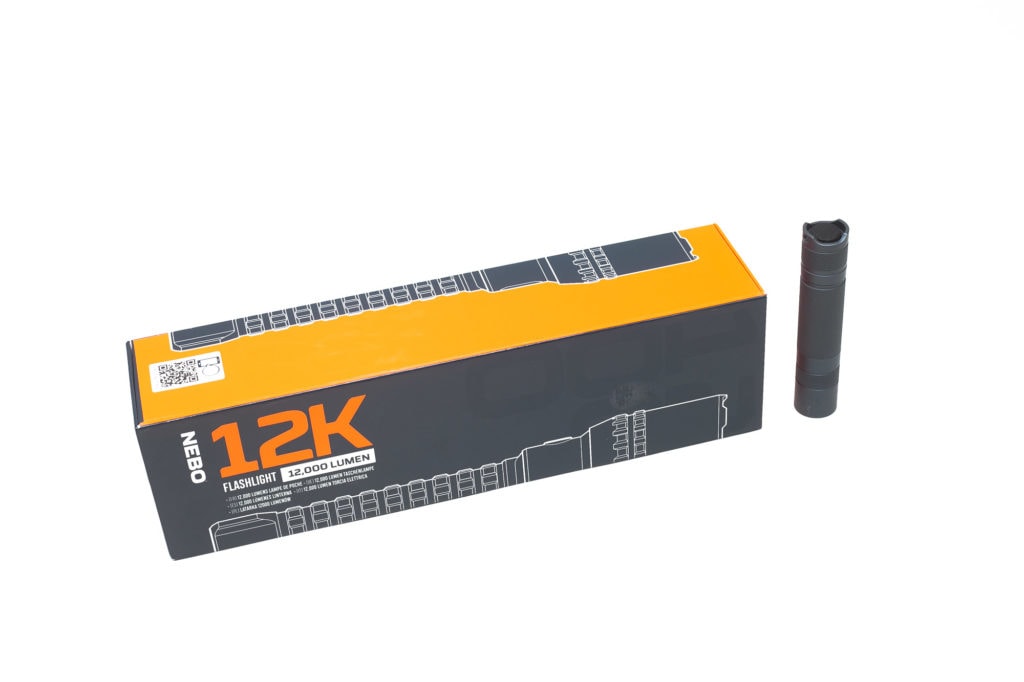
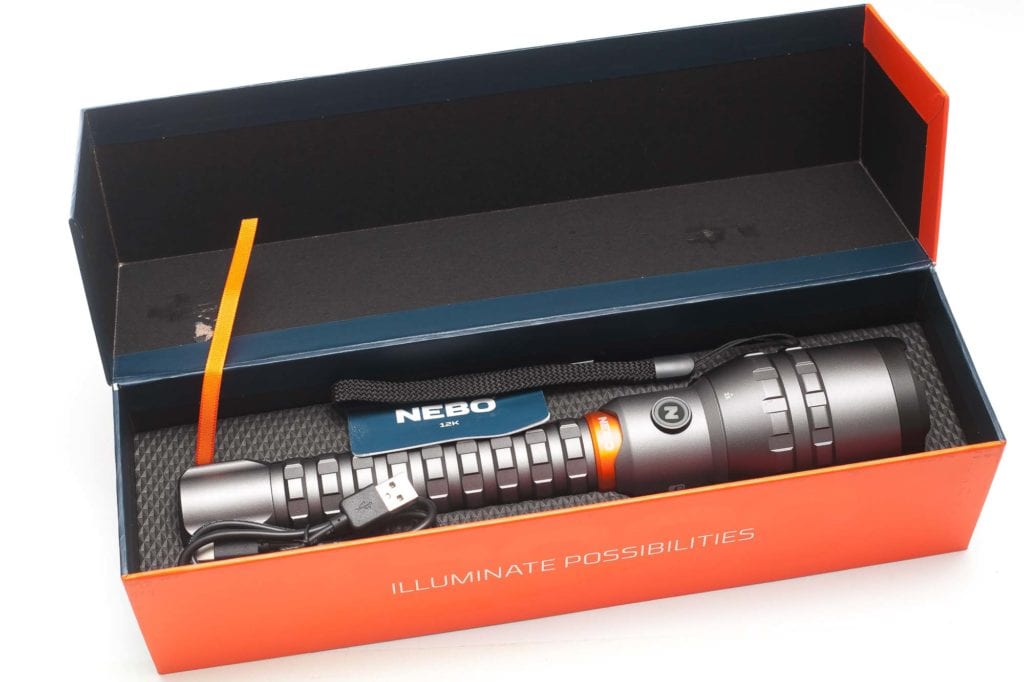
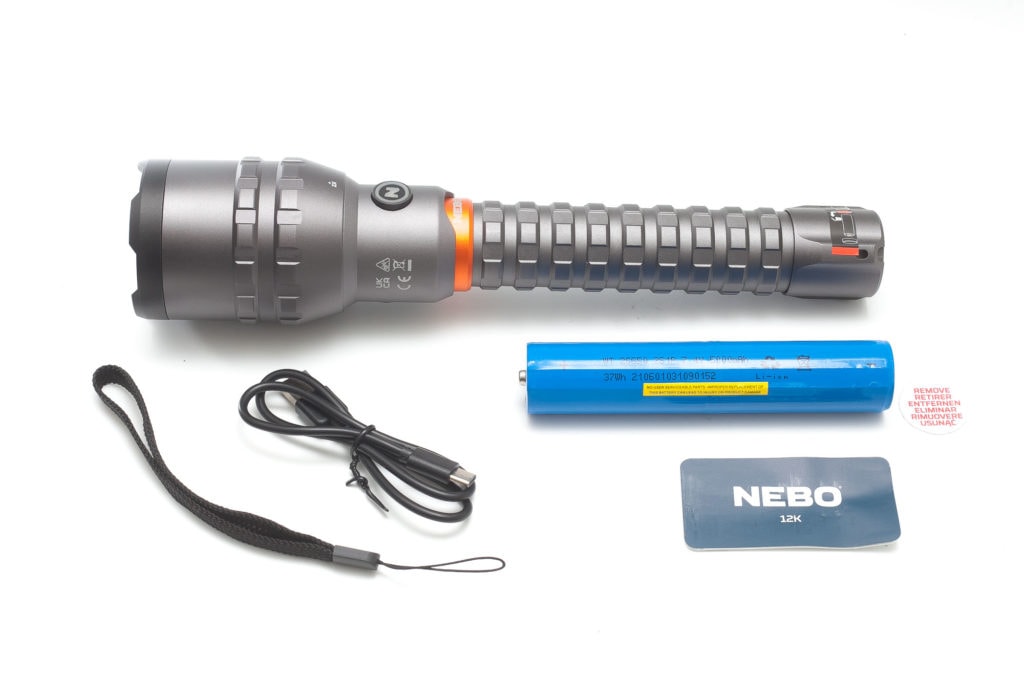
Flashlight in use
This is a hefty and large flashlight. It’s longer than a Maglite 3D and longer than 90% of my flashlight collection. It has considerable weight to it, at almost 800 grams (28oz). So no, this is not your next keychain or EDC flashlight.
There’s only 1 switch located on the neck of the flashlight, just above the orange ring. The same orange ring is about the balance tipping point. It’s also where your index finger will naturally rest, so I assume that was done on purpose. Great idea, by the way. Just the right balance for carrying.
You’d only need 1 hand to operate it, so that’s good. But when you want to use the 2X zoom feature, you’d have to use the other hand to twist the head. And I’ll be honest (and share the data below), the zoom feature is ineffective.
So it would be great for camping and such, but because of the weight, it’s not ideal for hiking or backpacking.
Oh, in case you wondered, it does have a lanyard attachment on the tailcap. The holes are large, and it is easy to get the lanyard through.
The switch has a ridge to protect it from accidental activation. And when the light is turned on, it’s backlit to indicate the battery level. When it’s pitch black, you can find the switch rather easily, even without it being lit. But it’s a bit harder when you use gloves.
Although it’s pretty long, it can tailstand. Just be careful not to knock it over because it can really hurt, dropping it on your toes. This thing is heavvvyyyy.
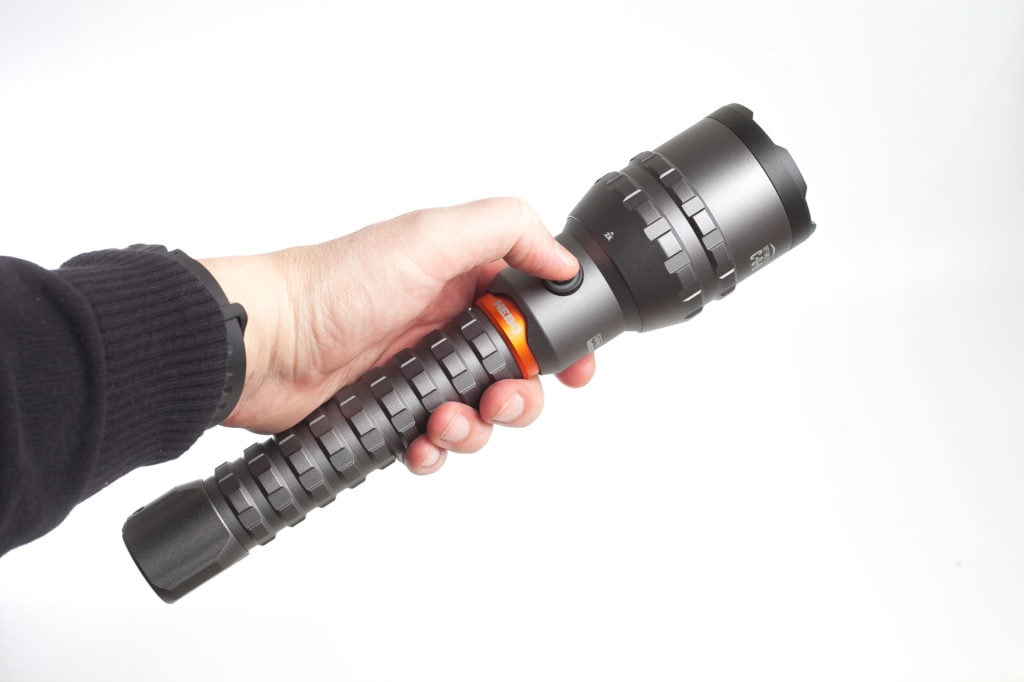
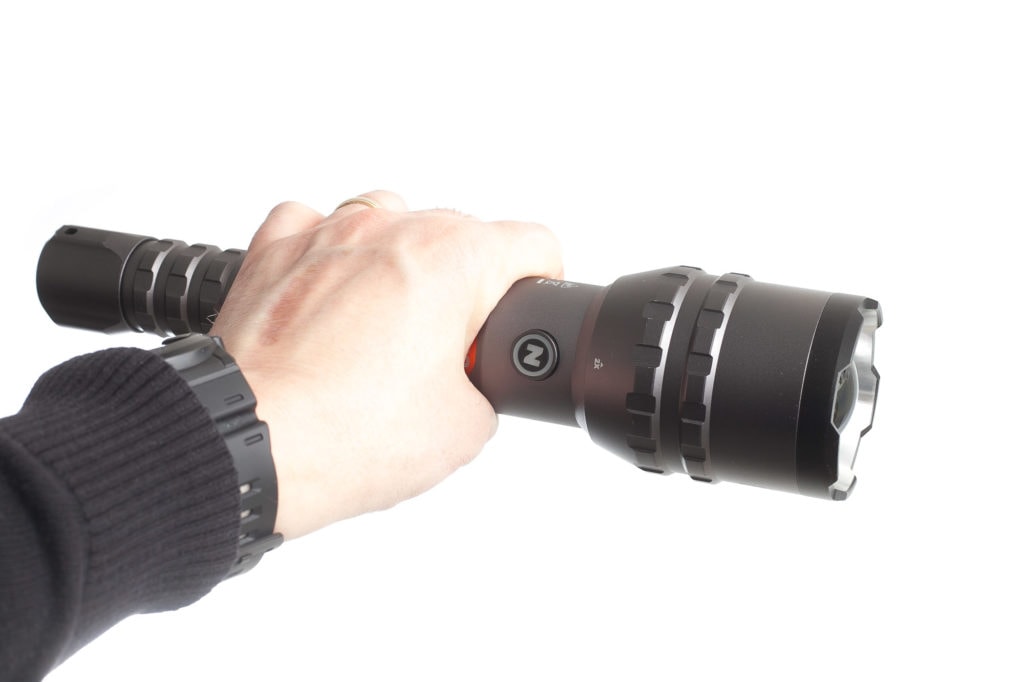
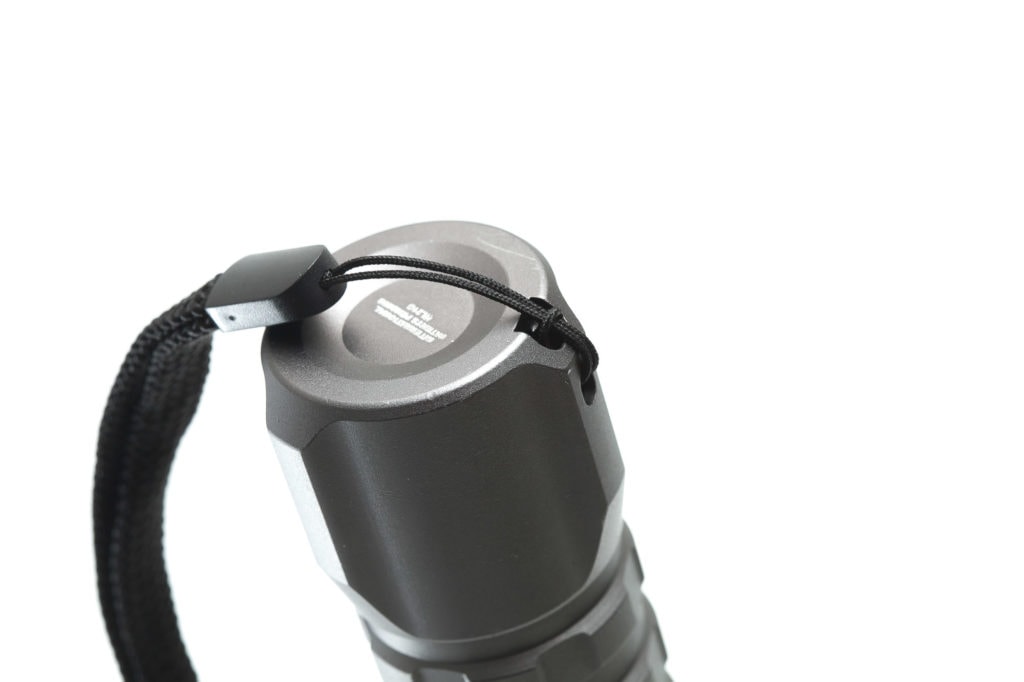
Build Quality, and Warranty
We normally look at a few things when it comes to build quality. The first thing is anodization. That’s like a protective coating layer on top of the aluminum body. On most flashlights, this is black, but on the Nebo 12K it’s grey.. btw… like on most Nebo lights because that’s their unique brand color.
I’ve been testing it and doing beam shots and have already noticed a few small spots on the anodization. They’re mostly on the edges and look less durable than other types of anodization.
Secondly, the machining. Some flashlights suffer from poor machining with visible machine marks and sharp edges. But the 12000 lumen 12K looks very good, with all the edges nicely chamfered. Even the crenelated bezel doesn’t feel too sharp.
The zoomable head screws up and down smoothly, with no wobble on either end (completely zoomed in or zoomed out), but it has a little wobble when focused halfway.
The bezel is removable and gives you access to the inside of the head. No glue was used, so that can be nice for the more curious-oriented people among us.
The tailcap can be removed very easily and protects the light from water ingress by 2 o-rings. Threads are bare and have very little lubrication if any. Since bare threads get dirty quite easily, you must maintain them routinely and add some new lubrication.
Warranty:
The short manual shares the following: This product is guaranteed against all defects in workmanship and materials for the original owner for two years from the date of purchase.
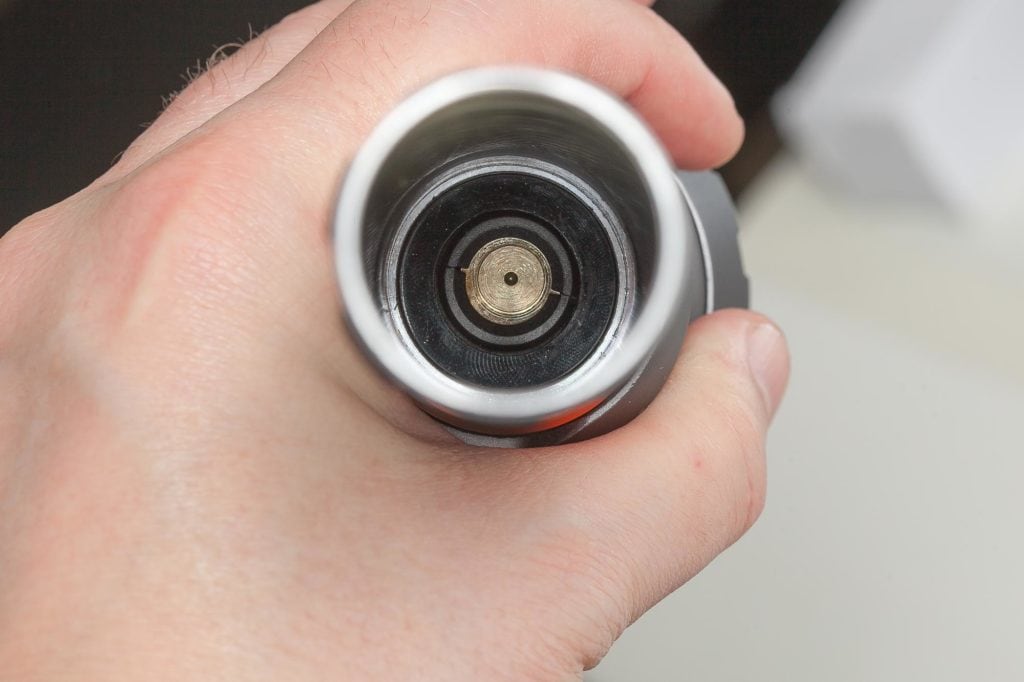
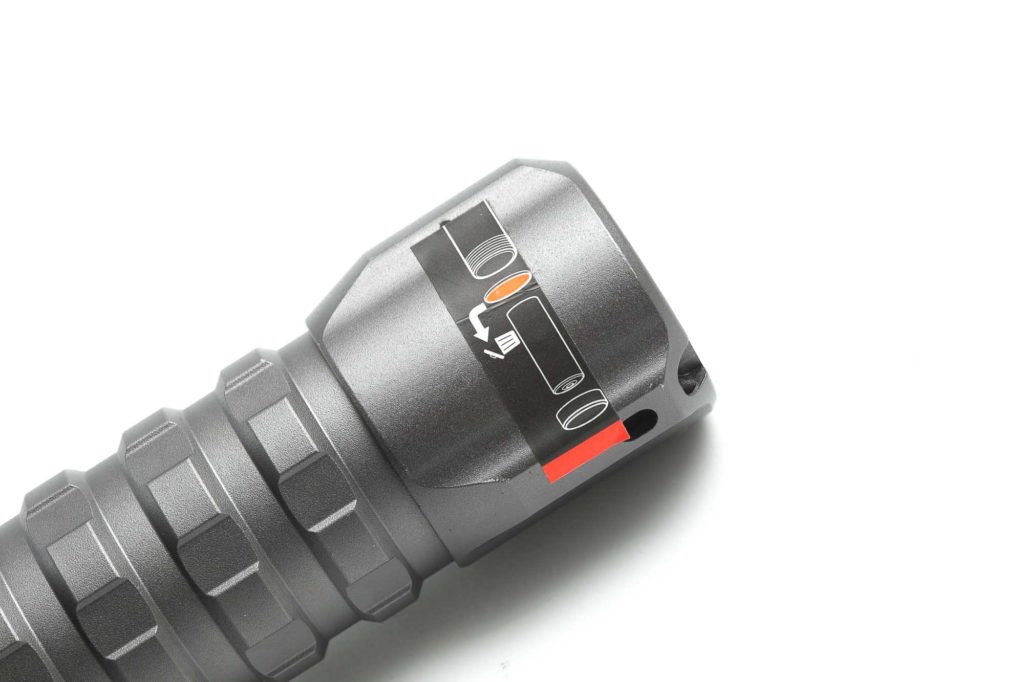
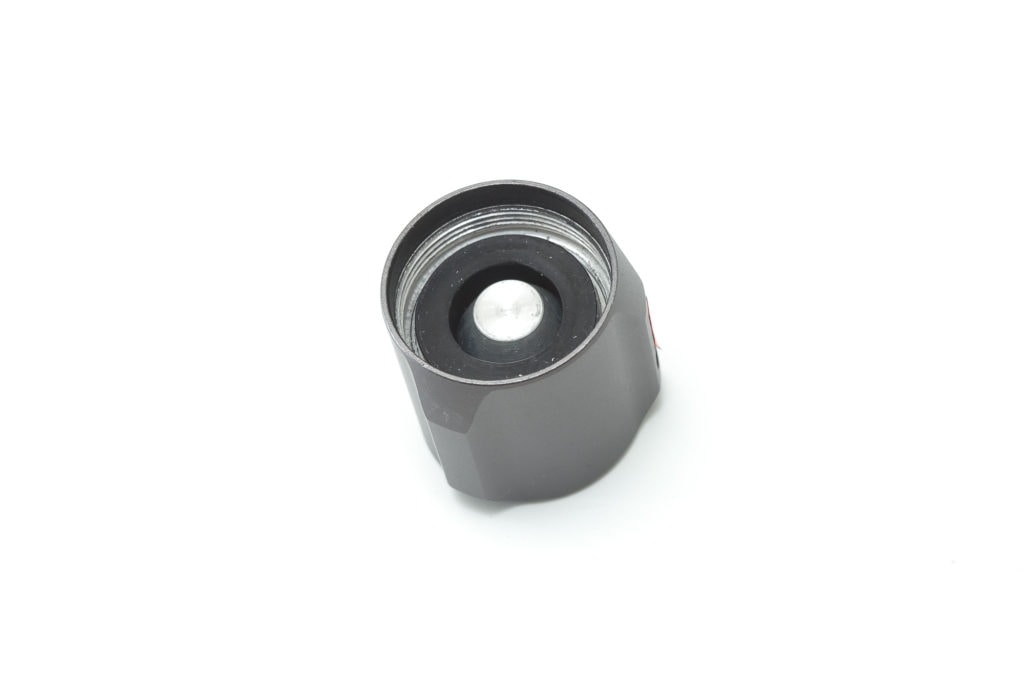
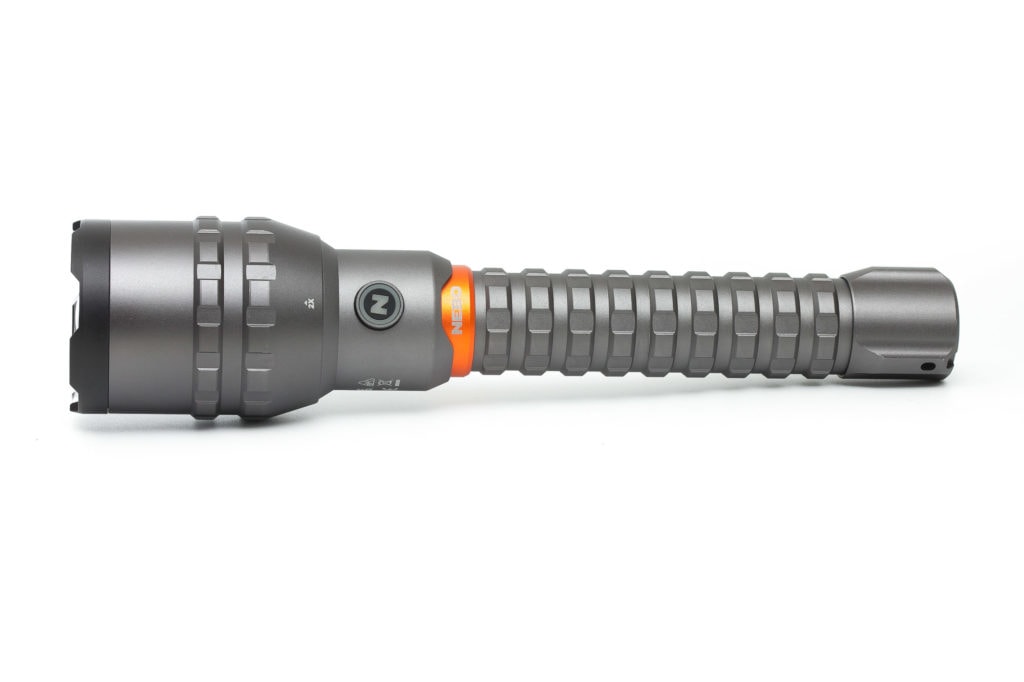
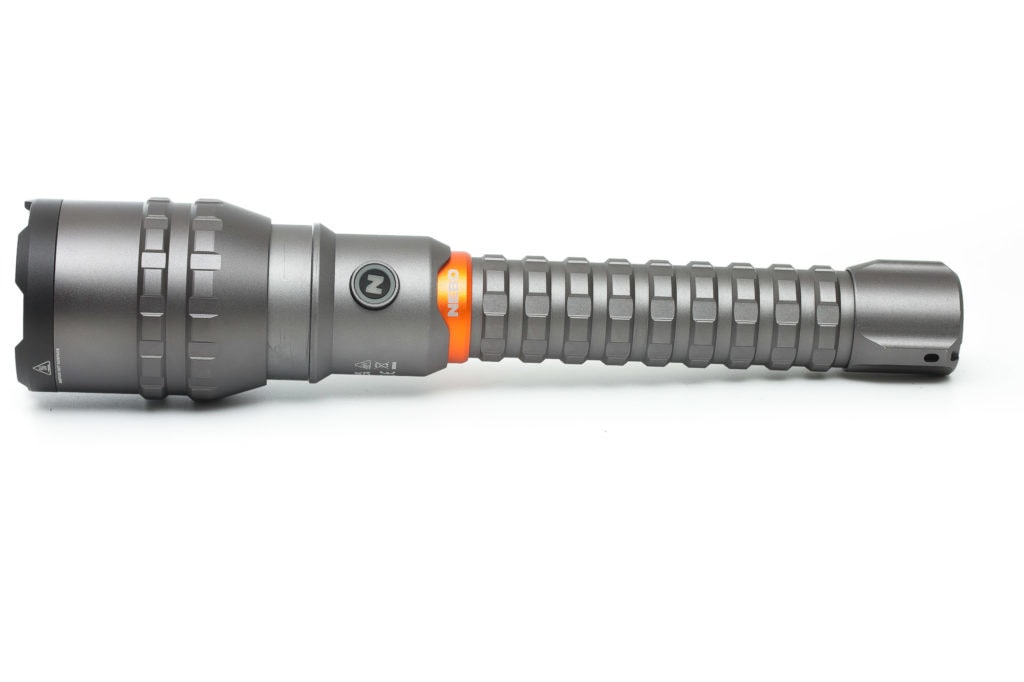
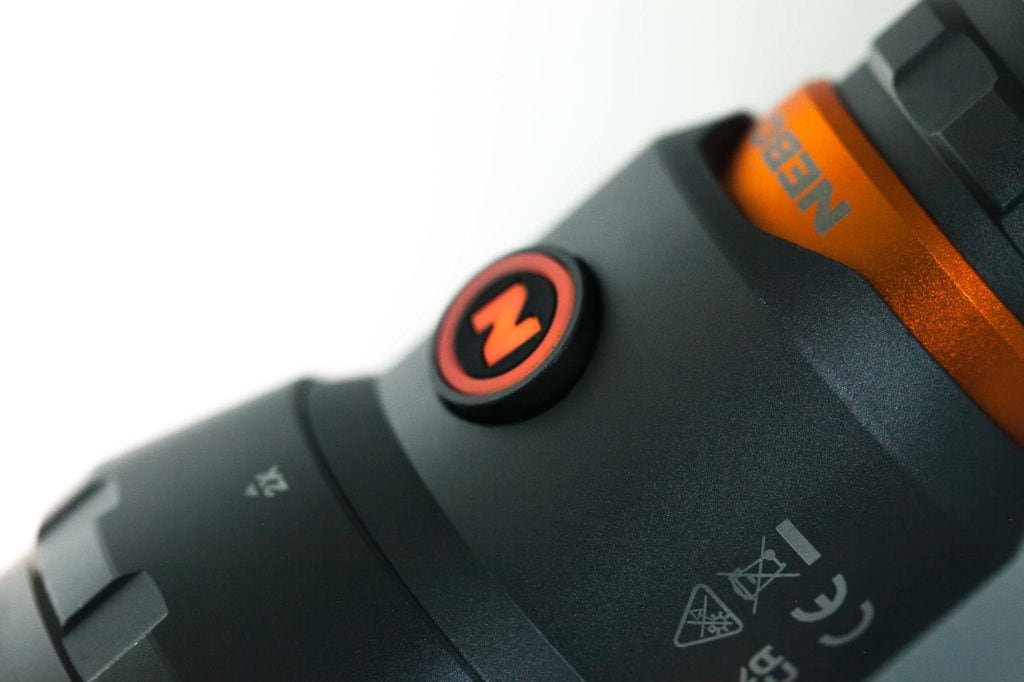
LED, Lens, Bezel, Beam, and Reflector
The Nebo 12K has a rather unusual type of light source. Unlike 99% of flashlights on the market, it’s using a COB (chip on board), and is enormous compared to a ‘normal’ LED.
It sits behind a huge (plano) convex lens, which is unprotected. This means that the convex lens is exposed and can be damaged. And most zoomable flashlights use this same setup. But adding a glass lens for front protection can be great. It’s much easier to replace a standard protection lens than finding the right convex lens with the right size and angle.
The bezel has no glue and can be removed by hand. No need to have any special tools. This will give you access to the convex lens, which is held in place by the bezel and a thick o-ring. Once removed, you get access to the COB LED. An easily removable retaining ring keeps the light source in position. You’d have to unsolder the wires to remove the light source as a whole. Haven’t done that.
LED measurements
I set the light to high mode and used the widest beam. I then measured the center of the beam at a distance of about 70-80 centimeters. I used the Opple Light Master 3 for this, which gave me the following readings:
- Light temperatures in CCT: 6207K
- Ra (CRI): 68.9
The beam temperature is what we call Cool white, with a low color rendering index.
I tested it again, but now zoomed in (tightest beam), and got the following:
- Light temperatures in CCT: 6106K
- Ra (CRI): 68.7
You can see that both measurements were very close in terms of CCT and CRI.
The beam is just a wall of light, without a prominent hot spot. And although pretty cool white, it’s not that bad in person unless you want to observe plants from up close.
In the images below, you can see that Turbo has no PWM/flicker, but High mode has (although not visible by the eye), and Low also has (also not visible because it looks like it’s each row of LEDs in the COB that turn on/off.
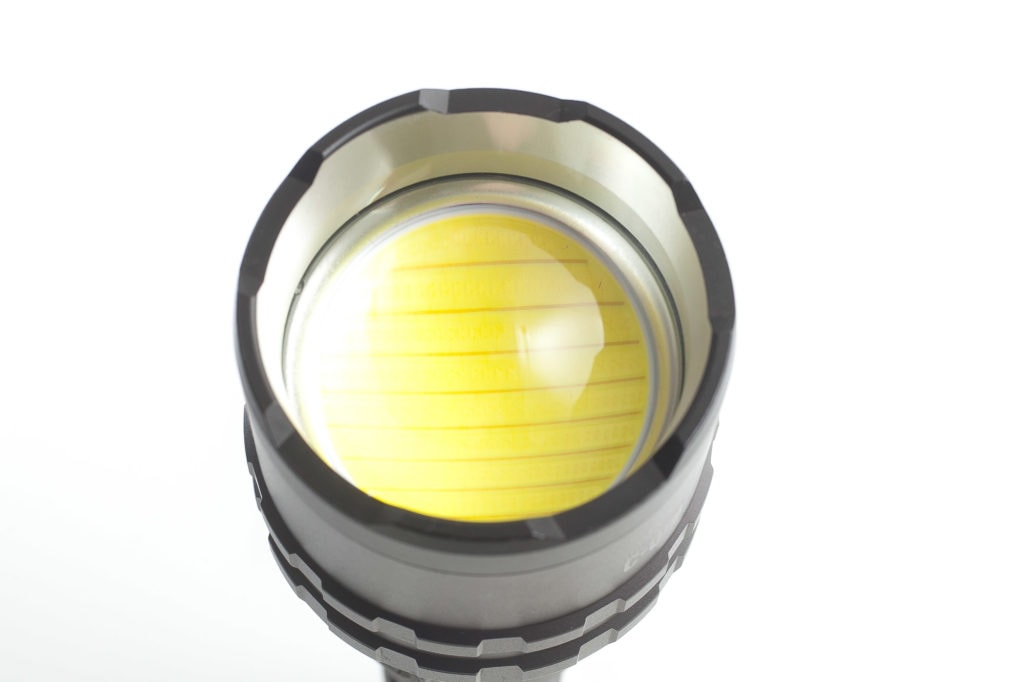
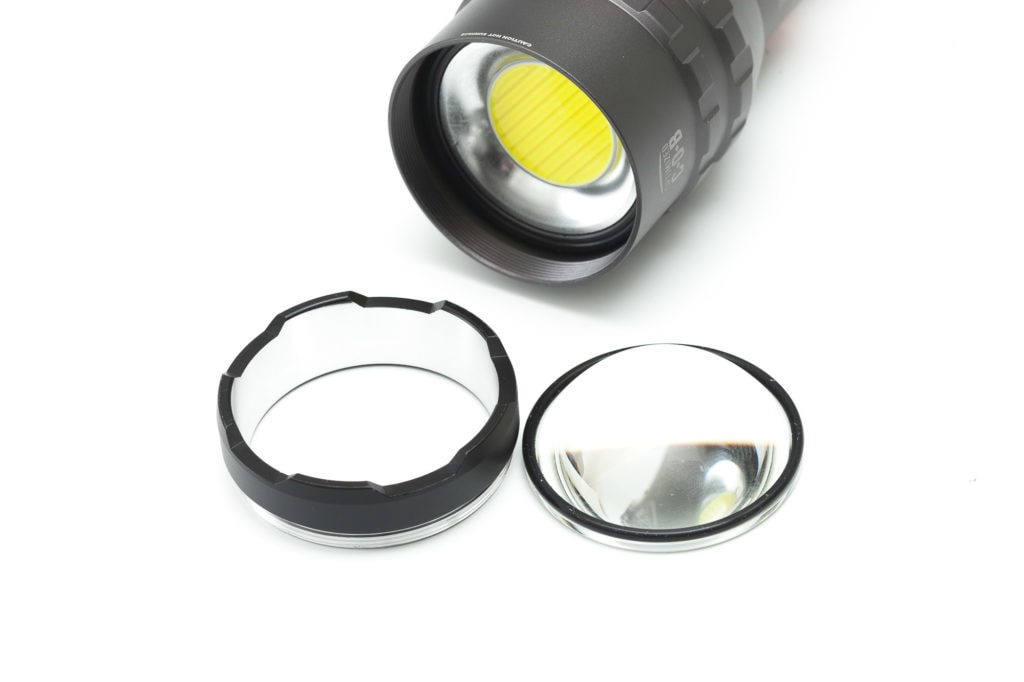
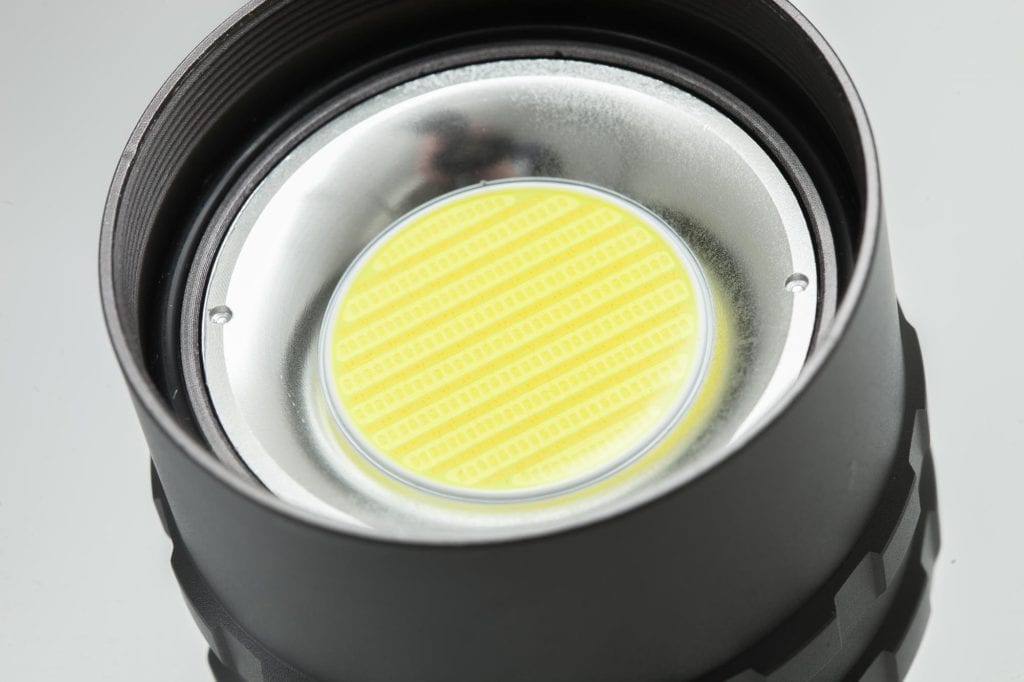
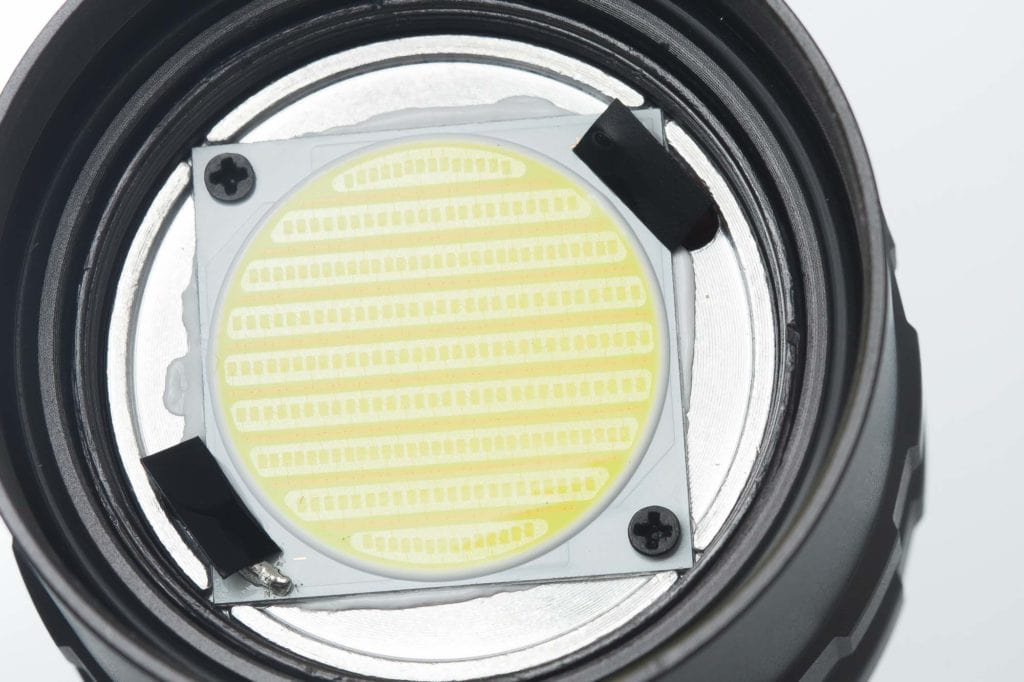
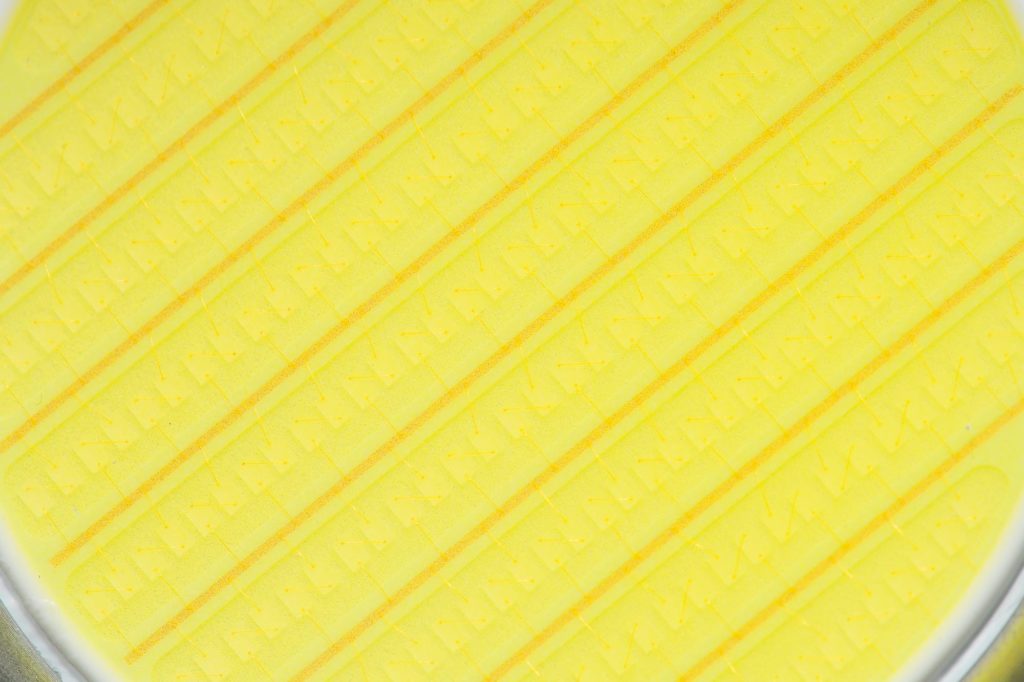
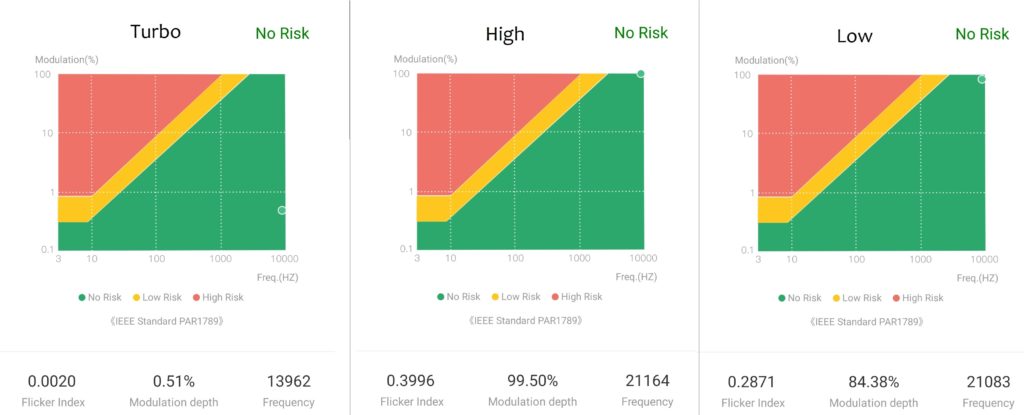
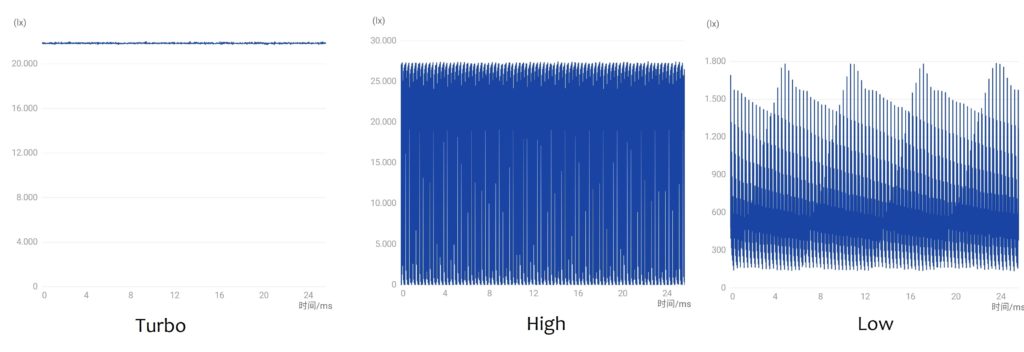
Dimensions and size comparison
- Length: 280 mm / 11 ”
- Length zoomed: 296 mm / 11.654″
- Head diameter widest: 63.9 mm / 2.51 ”
- Tailcap diameter widest: 36.5 mm / 1.438 ”
Weight:
- Empty: 601.2 g / 21.21 oz
- With batterypack: 797 g / 28.12 oz
Long flashlights comparison
Size compared to other Nebo flashlights: Nebo Galileo 1000, Nebo Slyde King 2K, Nebo 12K, Nebo Luxtreme SL100
Next compared to other flashlights, from left to right: Nebo 12K, Maxtoch L2K, Maglite 3D, Astrolux FT03.
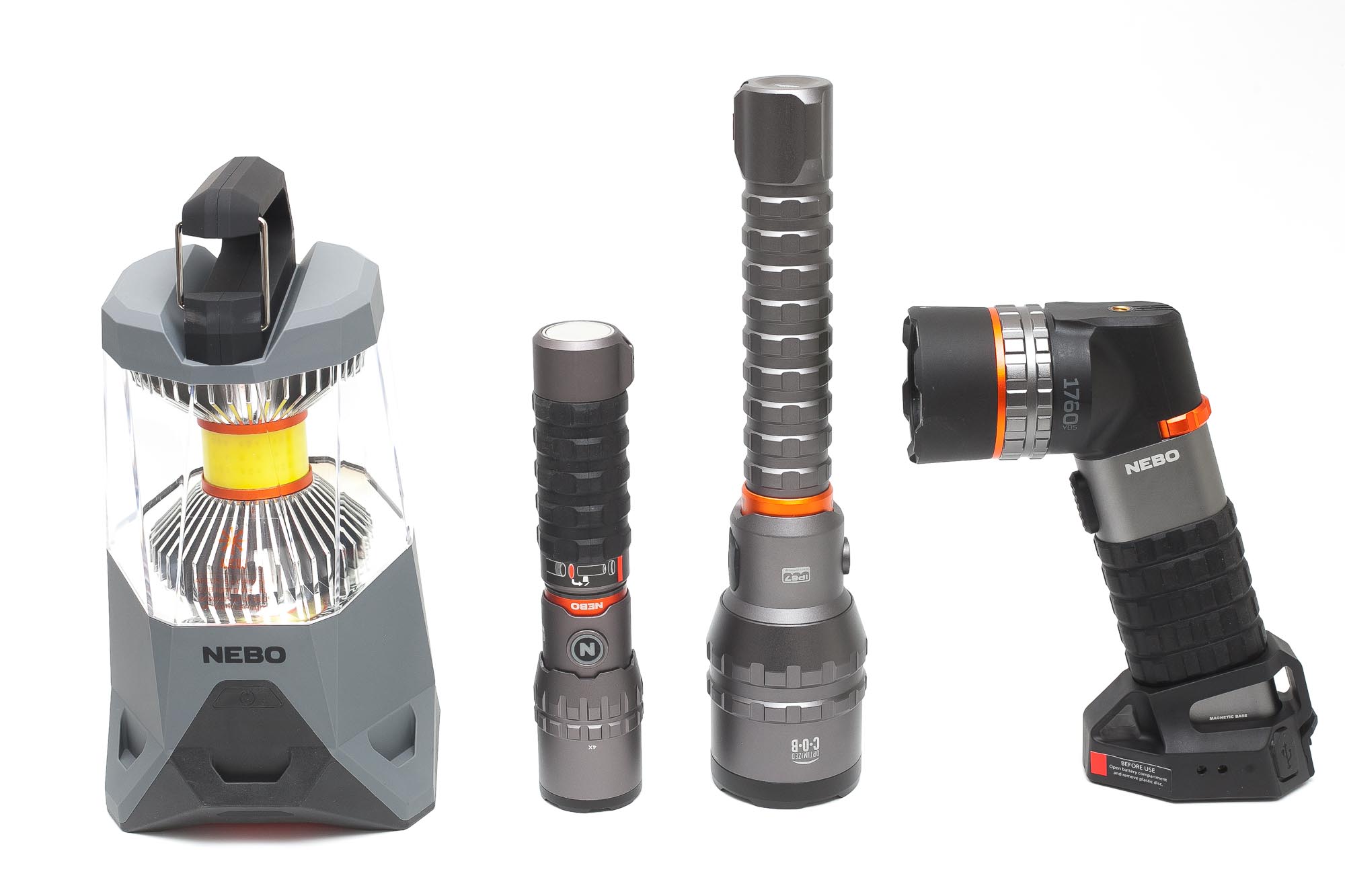
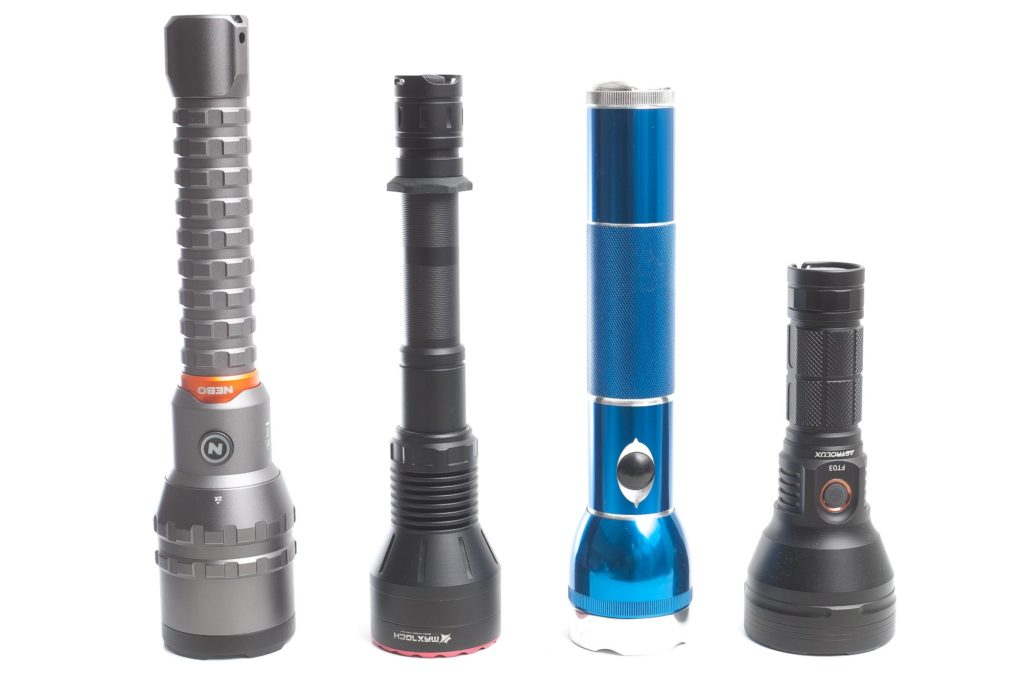
Driver & User Interface:
All 4 Nebo lights I’m currently testing use unique user interfaces. None is the same, which is quite interesting.
Available modes: 4
- Turbo, High, Medium, Low
- Main menu cycle: High, Medium, Low, Off..(Off is part of the menu, which is rather strange)
From OFF:
- Single-click: High
- Double click: Strobe
- Triple-click: nothing
- Press and hold: Low
From ON:
- If starting from High single-click <8sec: cycle to Medium – Low – Off
- If starting from Low single-click: <8sec: cycle to Medium – High – Off
- (If you wait longer than 8 seconds, a click will turn the light off (also strange)
- Double click: Strobe
- Triple-click: nothing, will just turn the light off
- Press and hold: ramps up to Turbo
Shortcuts:
- To Turbo: long-press from any mode.. not accessible from Off
- To Low: Long-press from Off
- To Strobe: double-click from On and Off
Mode memory:
- No, but you can get instant access to Low, High and Strobe
Blinky modes menu:
- Yes, strobe. Accessible with a double click
Low battery warning:
- Not really
Lock-out mode:
- No
PWM:
- Not very visible, but there is, according to the Opple Light Master data. Nothing to really worry about.
Firmware / UI Conclusion:
It’s unusual that you have OFF as part of the menu! Click High, click Med, click Low, click Off..
That’s weird for a flashaholic like myself. Also, when the light is on for more than 8 seconds, the next click will be off, instead of the next mode. That’s a little unpredictable when you are used to other UIs.
Fortunately, Turbo is still accessible after 8 seconds with a long-press
I’d rather have a long press for Off than Off being part of the menu.
Batteries & Charging
The 12K doesn’t come with a normal battery, but rather a dual-26650 lithium-ion battery, with a capacity of 5,000mAh each, and because they are connected in series, they have a Voltage of up to 8.4V (while maintaining a total capacity of 5000mAh). They fit snug, and there’s no rattling.
Note:
The battery pack looks special (and it probably is a little more than just 2 batteries connected) you can replace it with 2*26650 batteries, as long as they are button tops. I tried, and it works. They even charged with the built-in charging system.
But it’s not recommended because it could void your warranty.
After charging the battery inside the light, I measured it at 8.37V. So this means that each battery is at about 4.185 volts. That’s pretty good and pretty high. Some other brands have a lower finishing voltage to be safe, at the cost of peak performance.
Charging goes with the included USB-A to USB-C cable, and I measured a max charging current of 2.1A at 4.98V, so about 10.5Watt.
I tried to use a USB-C to USB-C cable with my USB-C power adapter, but that didn’t work. I also tried the USB-C port on my desktop, and it charged the 12000 lumens flashlight just fine at the same current as the USB-A to USB-C cable. During charging, the backlit switch breathes. This means that the light will fade in and out. It turns solid green when the charge has finished.
Power bank feature
The power bank feature can be a lifesaver. It will charge any device as long as you have the correct USB cable with you. I charged my phone, and it showed a peak charge current of 1.5A but settled at around 1.18A. I also tried to charge a flashlight (the Nebo Slyde King 2K), and it charged at about 500mA. That’s just a bit lower than the 700mA the Slyde King can take from a standard USB power adapter. I know it’s useless to charge a flashlight with a flashlight… lol
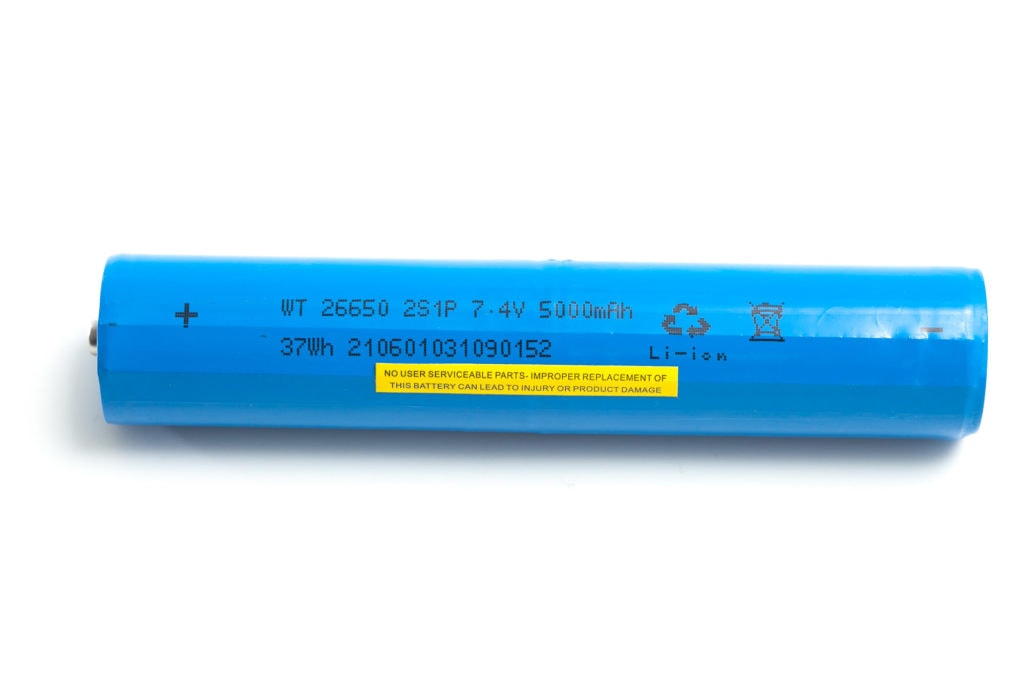
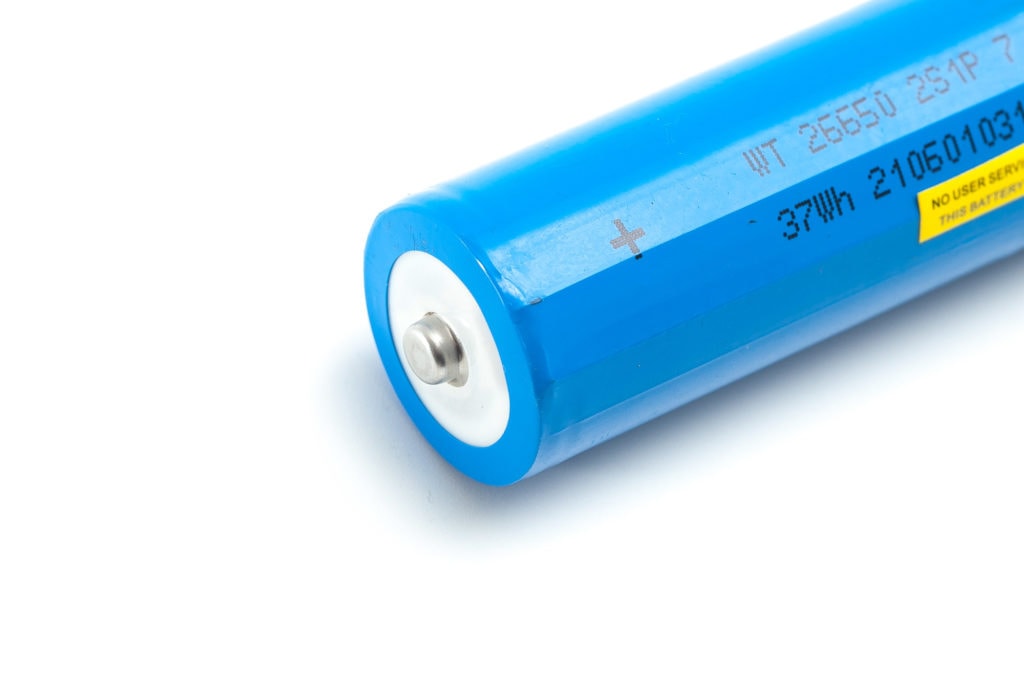
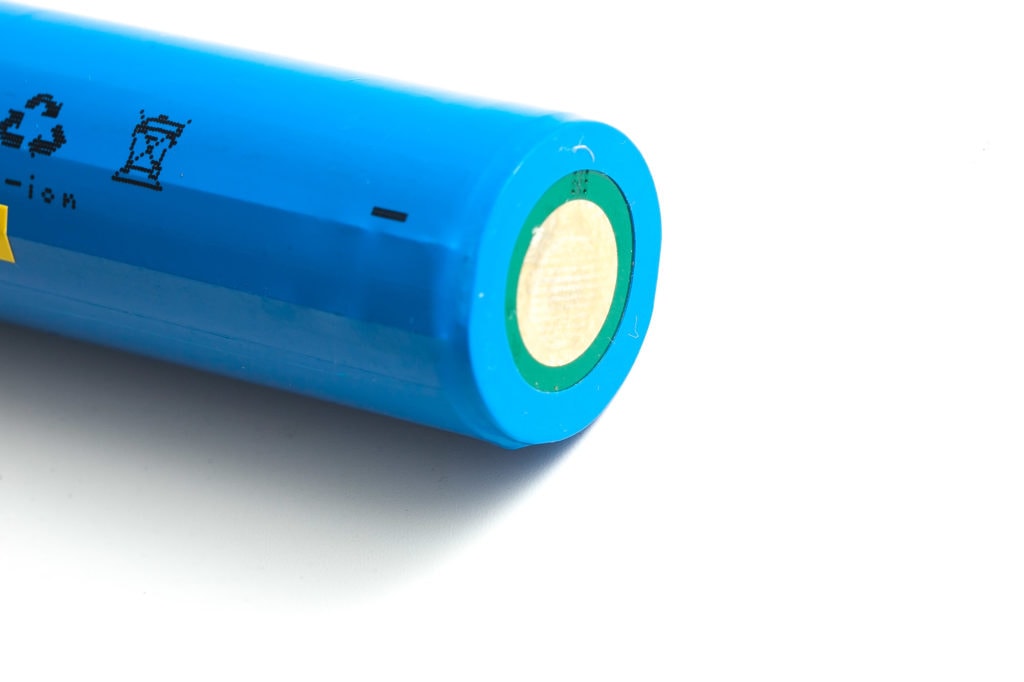
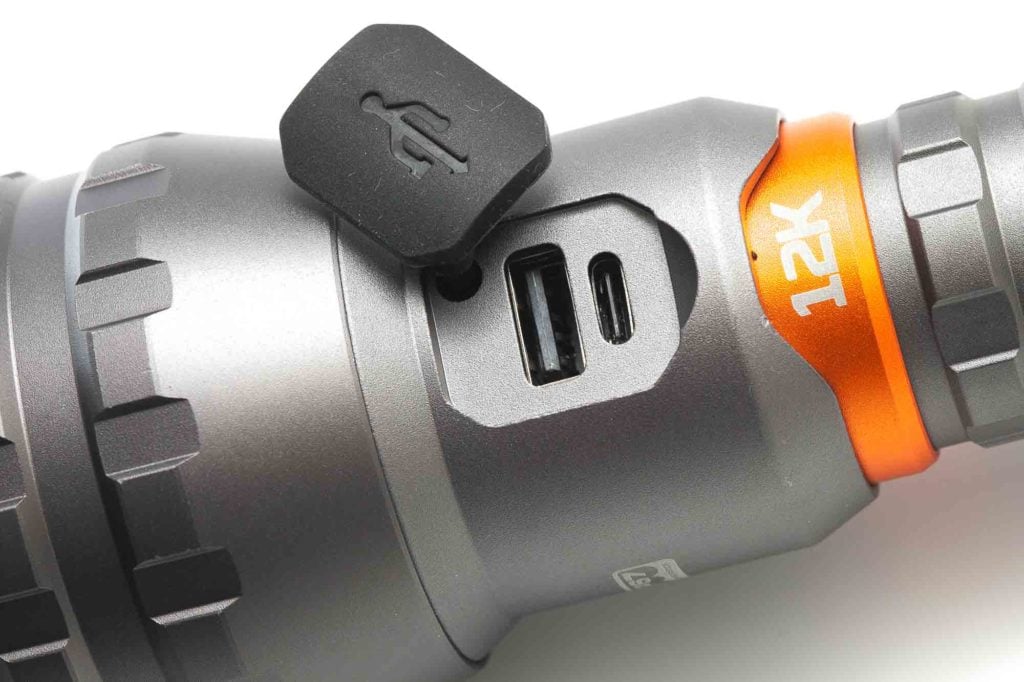
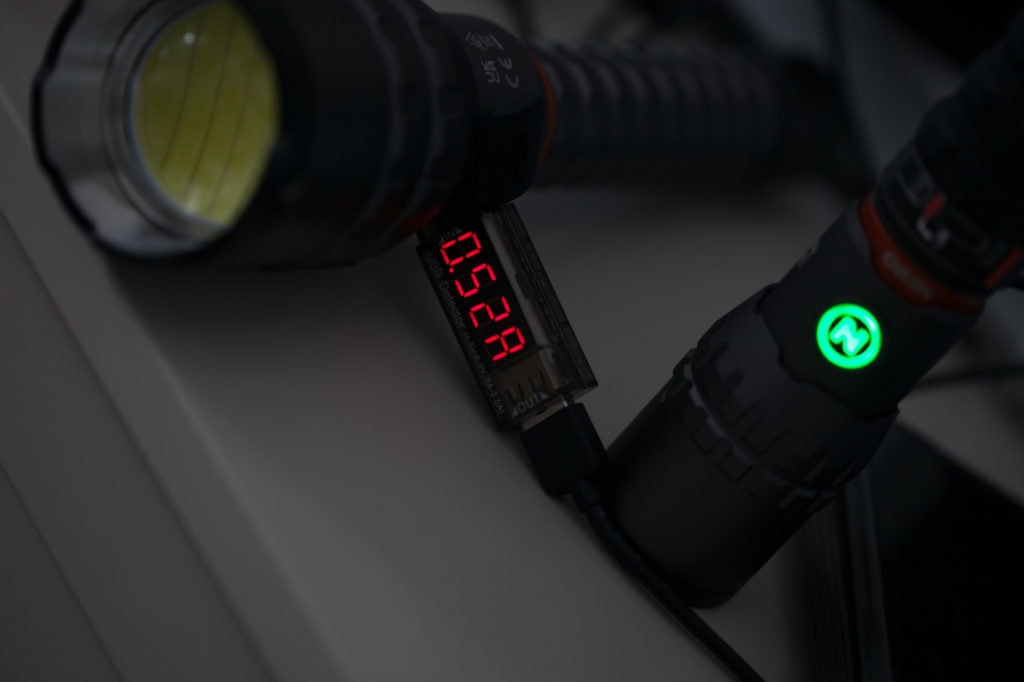
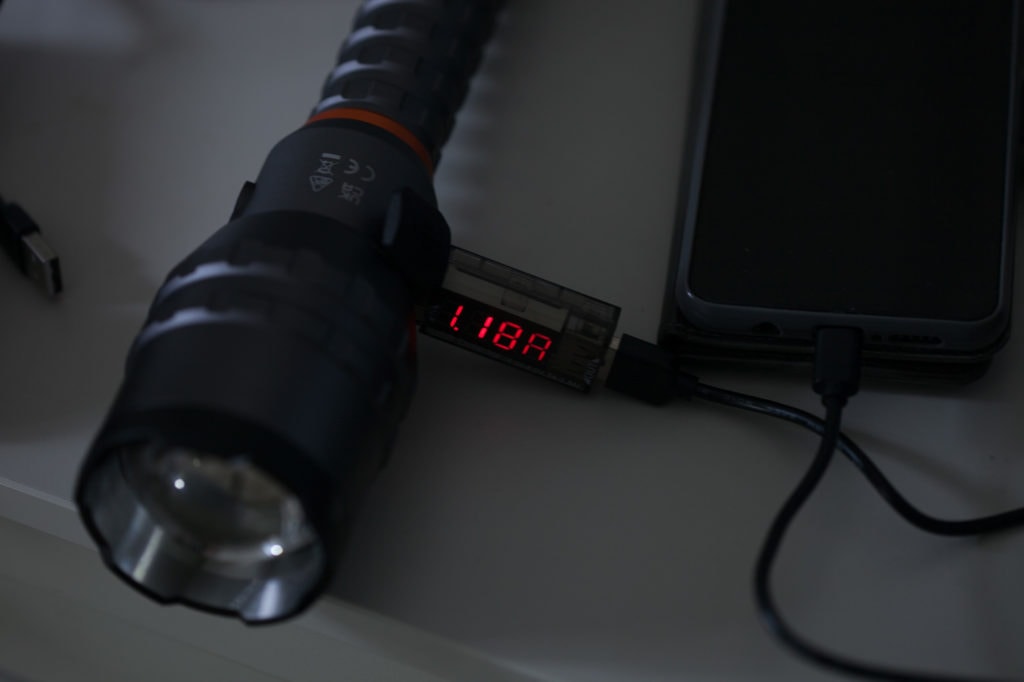
Performance test
Lumen measurements:
All output numbers are relative to my homemade Integrating Sphere. It is set up with an Extech SDL400 Lux Meter for measurements including a Kenko PRO1D ND-16 filter. The base measurement is done with a Convoy S2+ that has been tested at 255 lumens.
For Amp readings, I use a Fluke 77III DMM. For higher amps I now use a Fluke 325 True RMS clamp meter. For microamps, I use a cheap DMM with an easy-to-use micro amp setting.
I used the included batteries, and measured only High and Turbo with my clamp meter. I used the widest beam setting.
| Mode | Amp at start | Specs | start | 30 sec | 10 minutes |
|---|---|---|---|---|---|
| Low | – | 300 lm | 386 lm | 404 lm | 260 lm |
| Low (zoomed in) | – | – | 214 lm | 224 lm | – |
| Med | – | 3,000 lm | 3,006 lm | 3,345 lm | 1208 lm |
| Med (zoomed in) | – | – | 1,712 lm | 1,891 lm | – |
| High | 9.2A | 7,000 lm | 6,363 lm | 6,652 lm | 1598 lm |
| High (zoomed in) | – | – | 3,579 lm | 3,733 lm | – |
| Turbo | 17.25A | 12,000 lm | 13,061 lm | 11,630 lm | 1135 lm |
| Turbo (zoomed in) | – | – | 6,584 lm | 6,024 lm | – |
I calculated the loss of light when the flashlight was zoomed in. This was about 40-45%, even at a so-called 2x zoom. But the zoom wasn’t really zooming, to be honest, and I’ll soon show you the pictures and measurements.
My measurements were pretty close. As you may have seen, the output starts to increase from turn on slowly. Therefore, the 30-second measurements in Low, Medium, and High are higher than at turn-on.
Turbo mode reached above 12,000 lumens directly after charging the battery and cooling down the light with a fan before testing. So yes, this is a real 12000 lumen flashlight.
You should always keep in mind that the highest outputs of these lumenmonsters are dependent on many variables. Just to name a few:
- When the battery was charged (It provides most power directly after it finished charging. If you wait a few days or a few weeks, it won’t be able to reach the highest possible output)
- Ambient temperature (putting a high-power flashlight in front of a fan for a couple of minutes before gives the best results (I normally don’t do this, but sometimes, when I need to do multiple tests, I use a fan between the tests).
- Flashlight temperature. If the flashlight is warm, or even hot, it won’t reach its maximum output
- Battery state: older batteries and used batteries can provide less power at peak
Parasitic drain:
- 80 µA
- This is pretty good
Nebo 12K runtime test (battery life)
The runtime test was done with the 50cm integrating sphere, including the Kenko Pro1D ND-16 filter and Extech SDL400 data logging Lux Meter.
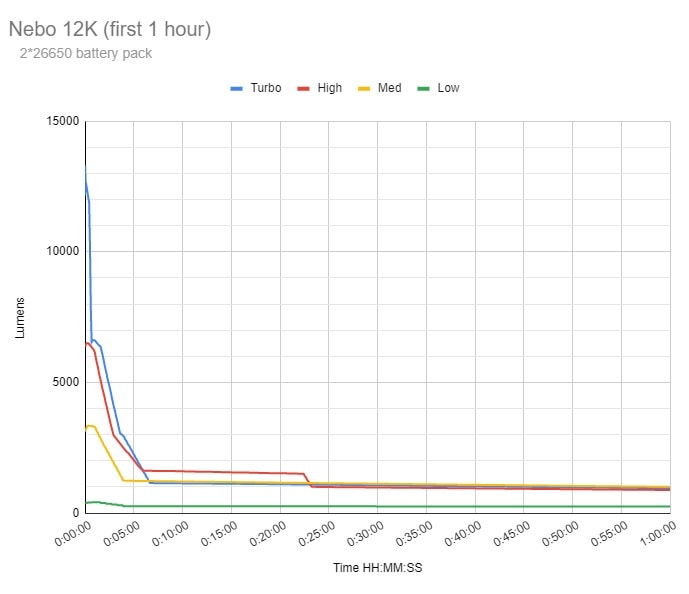
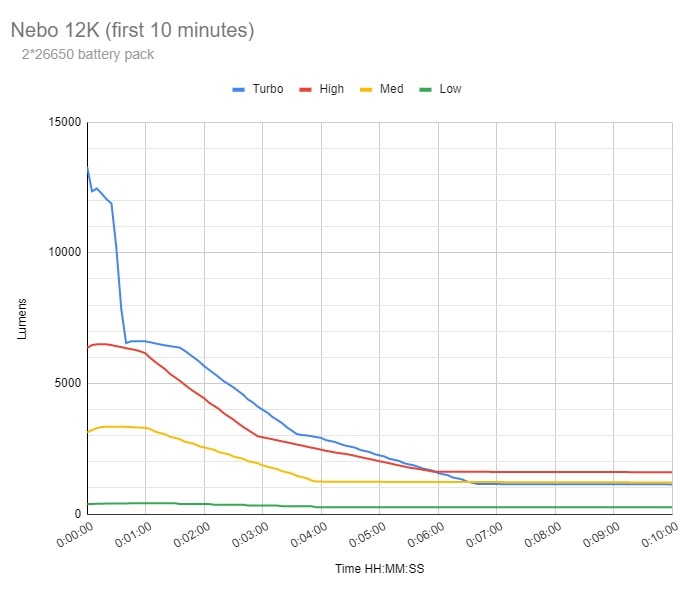
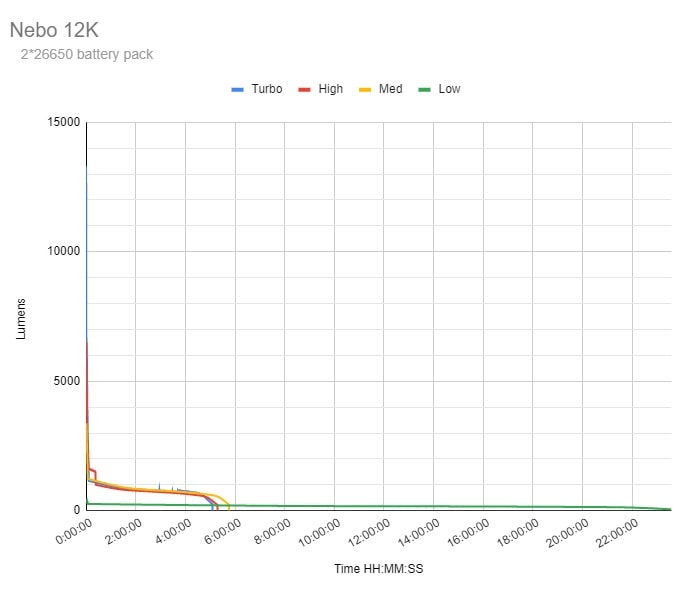
It’s hard to measure Turbo mode correctly because you need to hold the switch to ramp to Turbo, but it also drops directly, so the time interval of the Lux meter (at 5 seconds) is not the best to see the actual peak performance.
Within 40 seconds, Turbo was reduced to an output of 6600 lumens, then slowly decreased output until it reached 1150 lumens within 7 minutes. After 10 minutes, it produced 1135 lumens, and after 60 minutes it was down to 950 lumens.
According to ANSI FL1 standards, the total runtime is 10% of 11631 lumens, which is already reached within 10 minutes. But as you can see, that doesn’t mean the output is no longer useful in normal life. Even if you don’t have 12000 lumens at hand, 1000 lumen is enough for most people for most of the time. After 5 hours and 5 minutes, the flashlight finally turned off.
High mode started at around 6360 lumens and slowly increased before it started dropping again. After 6 minutes, the output is down to 1600 lumens. At the 22-minute mark, there is yet another drop to 1000 lumens. And then finally, after 5 hours and 17 minutes, the last measured output was 217 lumens before it turned off.
Medium mode: Turned off at 5h 45min
Low mode: finished at 23h 34min. The last measured output was 21 lumens before it turned off.
Throw Measurement
Measurements were taken indoors at 30 seconds (unless shown as at turn-on) with a professional Hagner E4-X Lux Meter. Numbers were taken 30 seconds after turning on.
Just before the 30-second mark, Turbo starts dropping … so it’s hard to get the exact measurement at 30 seconds. Because for Turbo mode, you have to turn the light on (in High) and ramp it up, which could reach Turbo just 1 second earlier or later.
Anyway, here are the numbers;
| Mode | Specs (in meters) | Candela | Meters | Yards |
|---|---|---|---|---|
| Turbo zoomed | 220 m | 10,750 cd | 207 m | 227 yd |
| Turbo zoomed (at turn on) | 220 m | 15,050 cd | 245 m | 268 yd |
| Turbo | 220 m | 10,075 cd | 201 m | 220 yd |
| Turbo (at turn on) | 220 m | 11,950 cd | 219 m | 239 yd |
| High zoomed | 164 m | 8,550 cd | 185 m | 202 yd |
| High | 164m | 6,625 cd | 163 m | 178 yd |
| Med zoomed | 114m | 4,275 cd | 131 m | 143 yd |
| Med | 114m | 3,475 cd | 118 m | 129 yd |
| Low zoomed | 36m | 500 cd | 45 m | 49 yd |
| Low | 36m | 425 cd | 41 m | 45 yd |
The table needs some explanation. I used the number of meters in the Spec column because that’s what Nebo shares. So you need to compare the Specs with the column Meters.
When it says Zoomed, it means that I focused the beam as much as possible. Nebo calls it 2x zoom, but as you can see, that doesn’t make sense. It’s not reaching 2 times as far, nor does the candela double (doubling the candelas doesn’t mean it reaches 2 times farther.
You need 4 times the candelas to reach 2 times farther). If you look at High mode, the candela went from 6,625 to 8,550 when zoomed in, which is about a 30% increase in candela. Regarding distance, let’s take High mode again: 163 meters vs 185 meters = 13% increase, so you can see that 2X focus doesn’t really mean what you think it means!
I measured Turbo mode 4 times. (zoomed in and zoomed out, and at turn on and after 30 seconds) just to give you a better overview.
Beamshots
For the following beamshots, I used a Canon EOS 5D Mk2 and a 50mm lens. manual settings: ISO1600, 1/4sec , F4, 5000K
The shed is about 65 meters / 71 yards away, and the reflective fence is 200 meters from the camera.
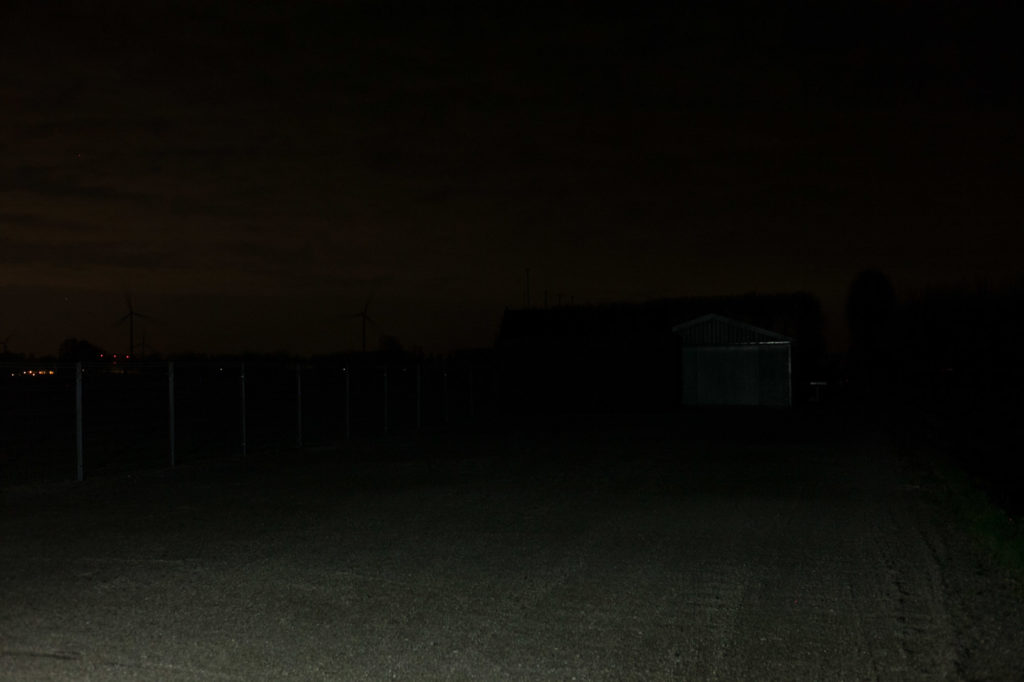
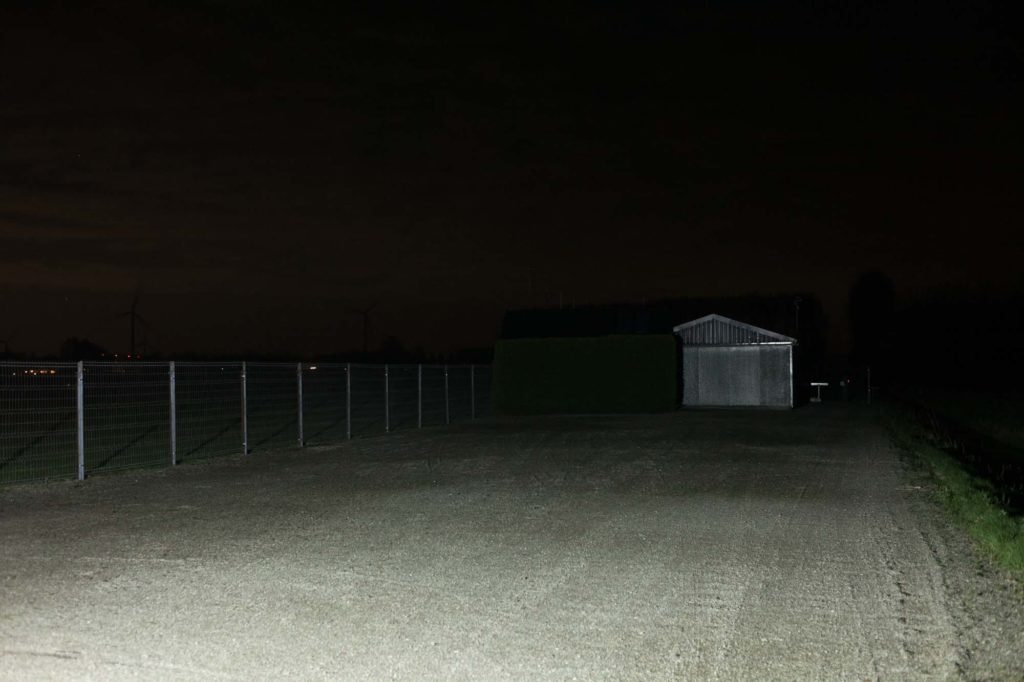
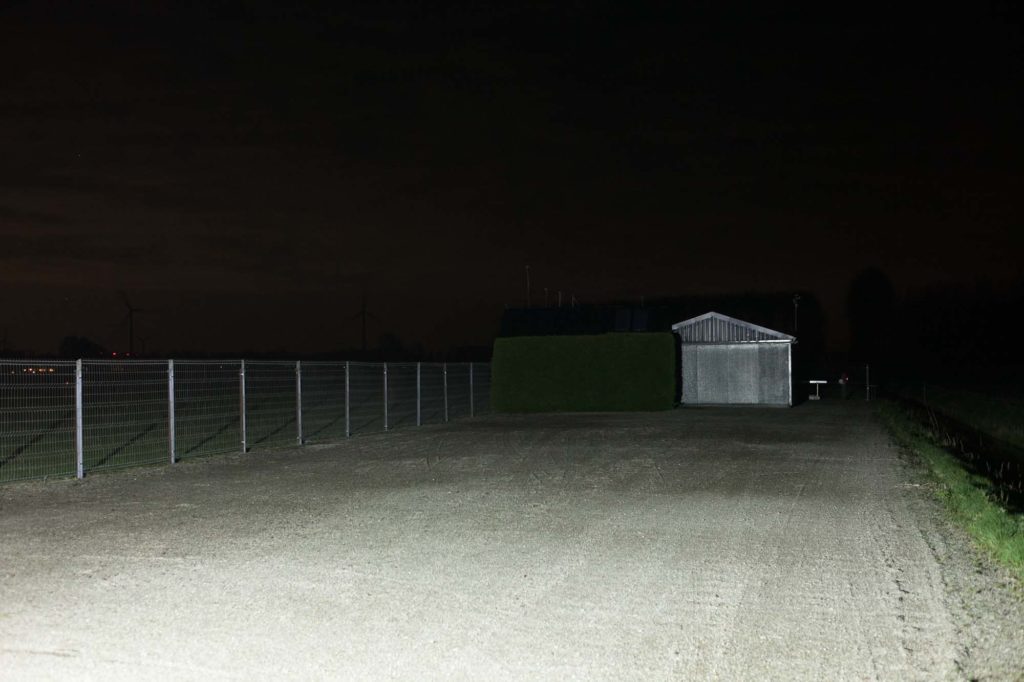
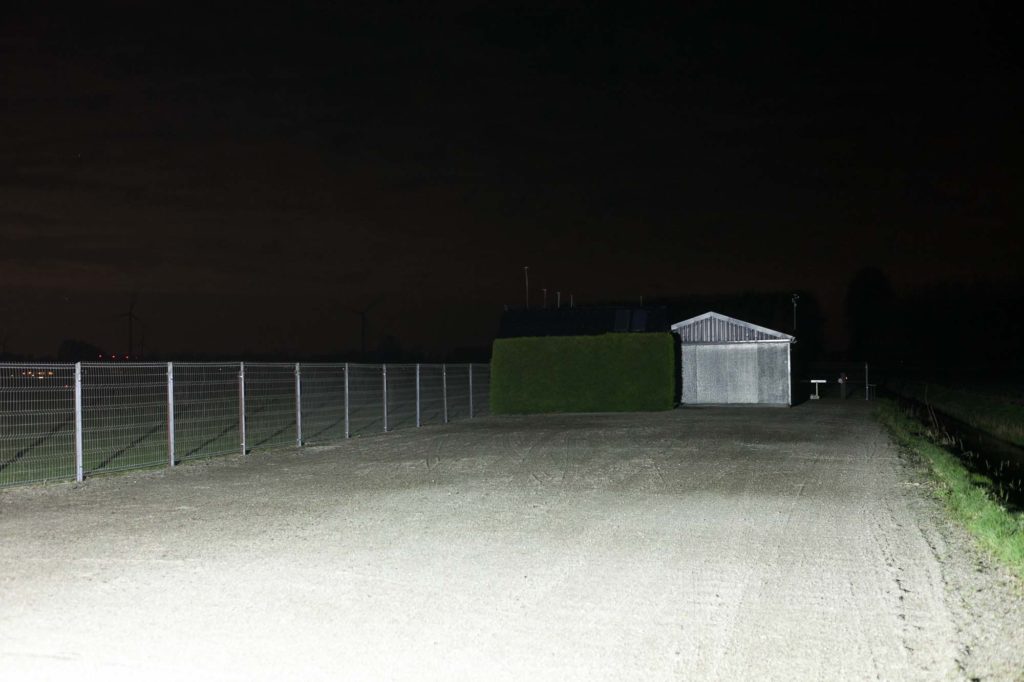
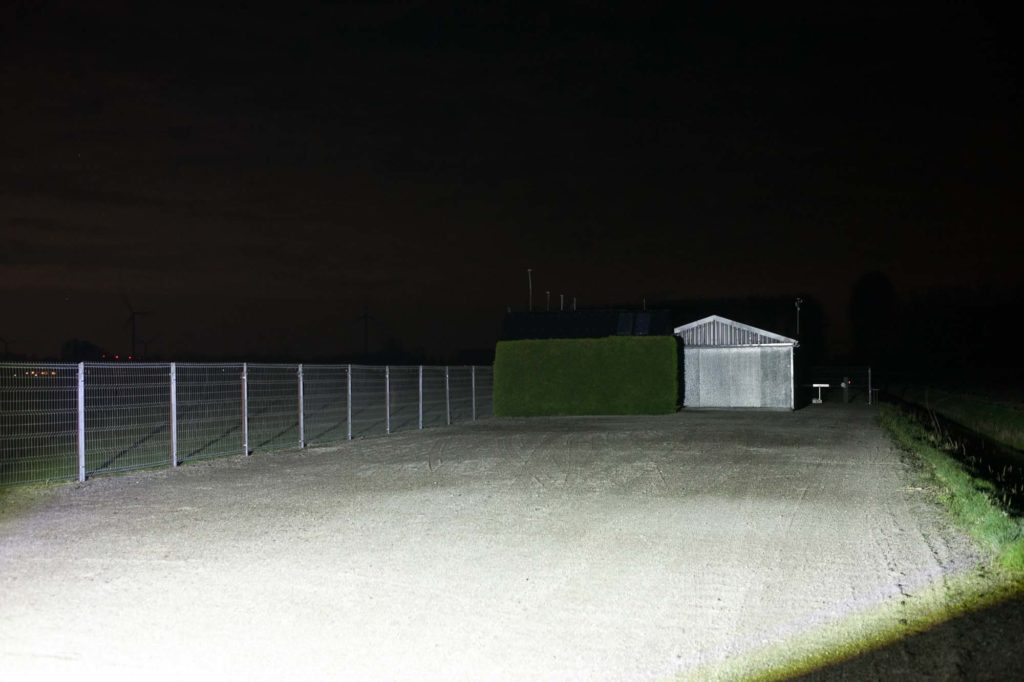
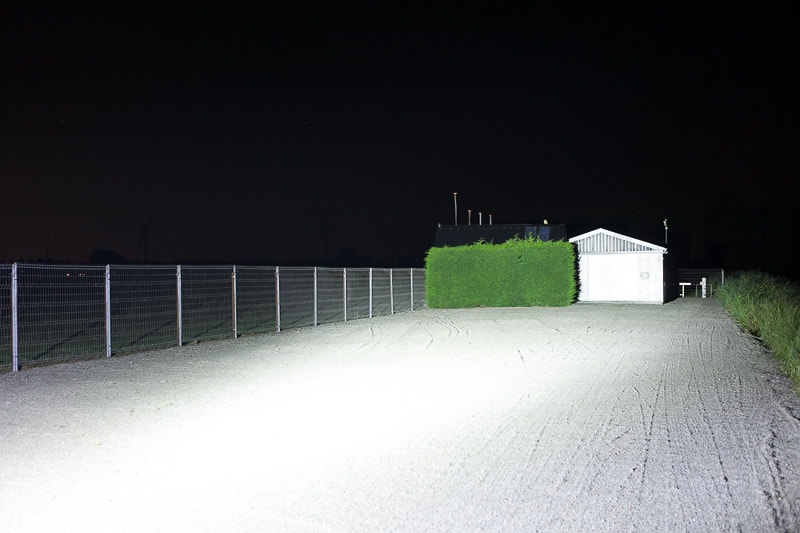
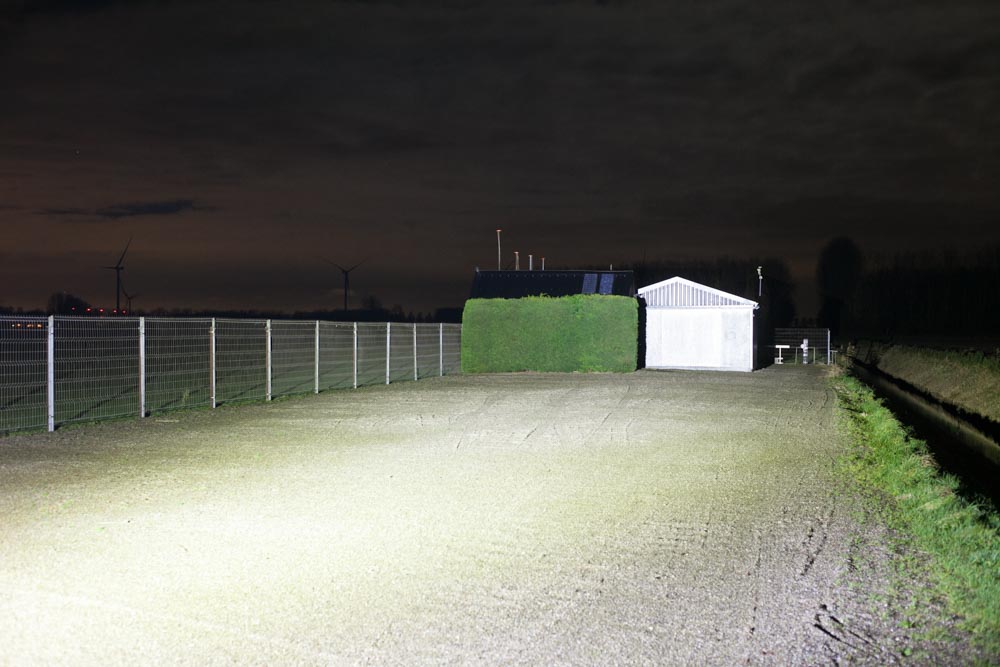
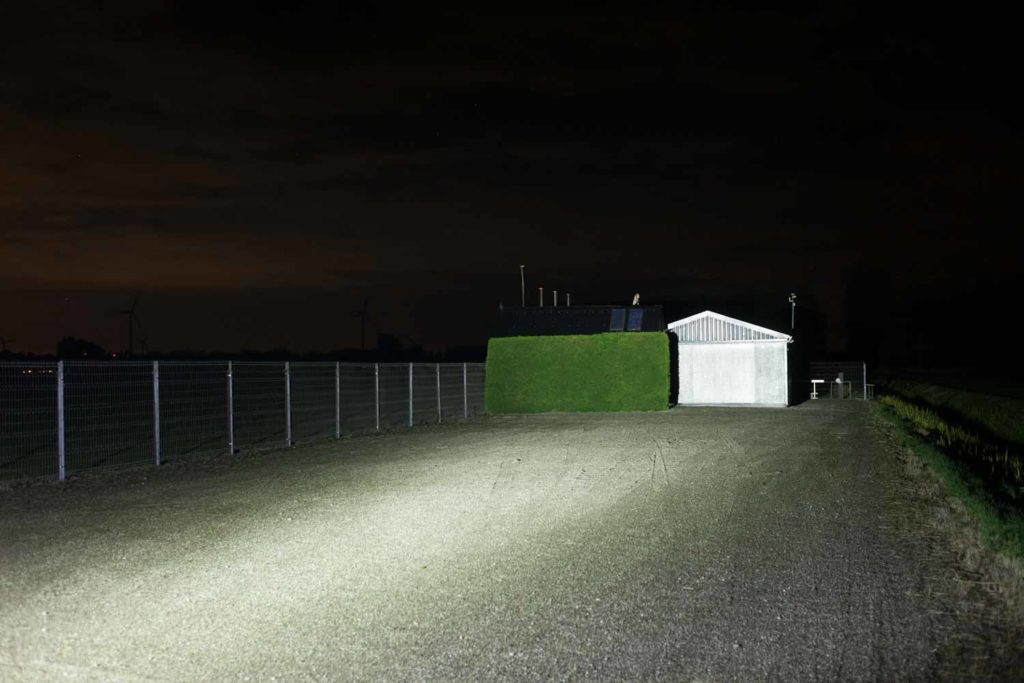
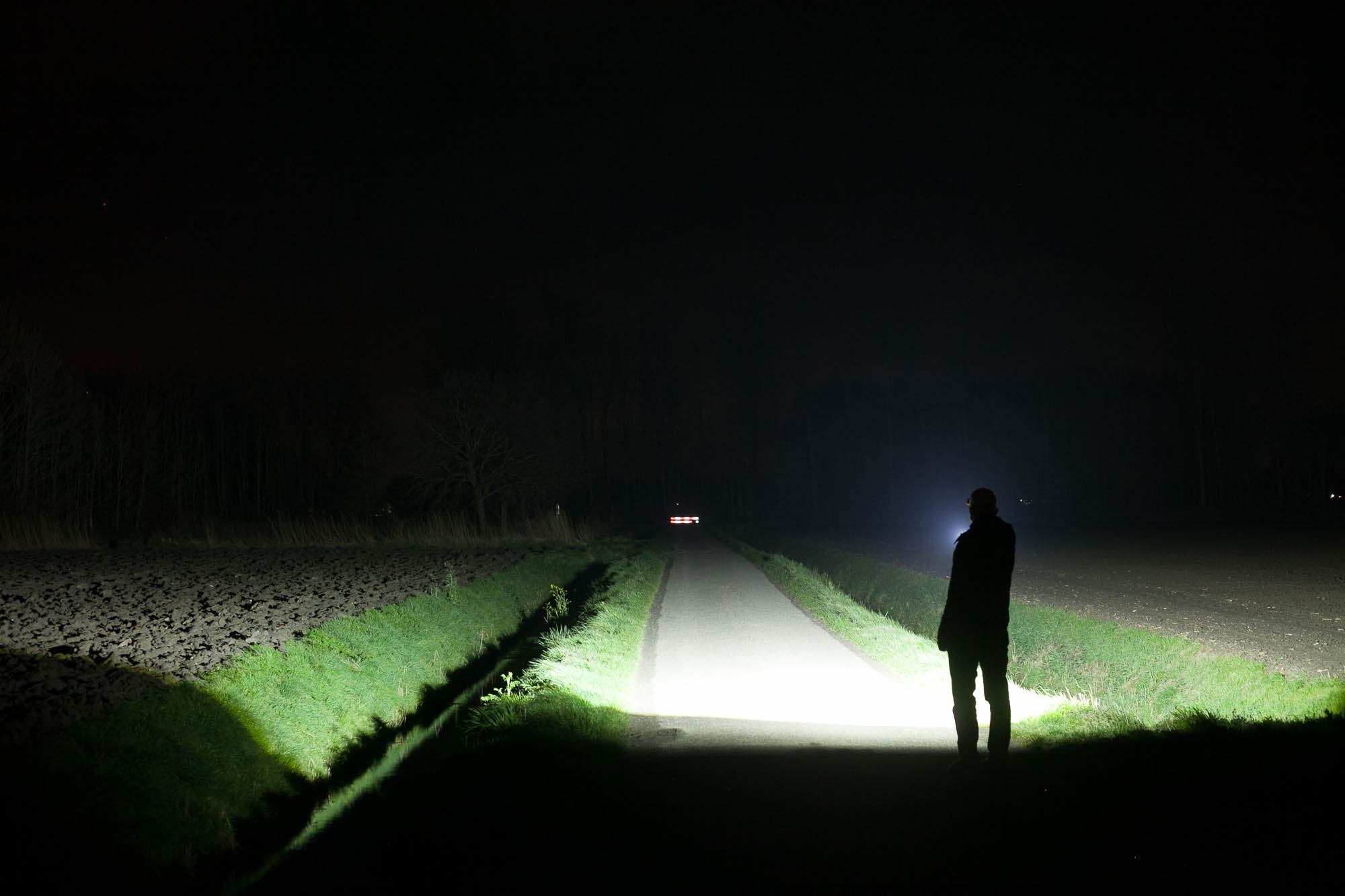

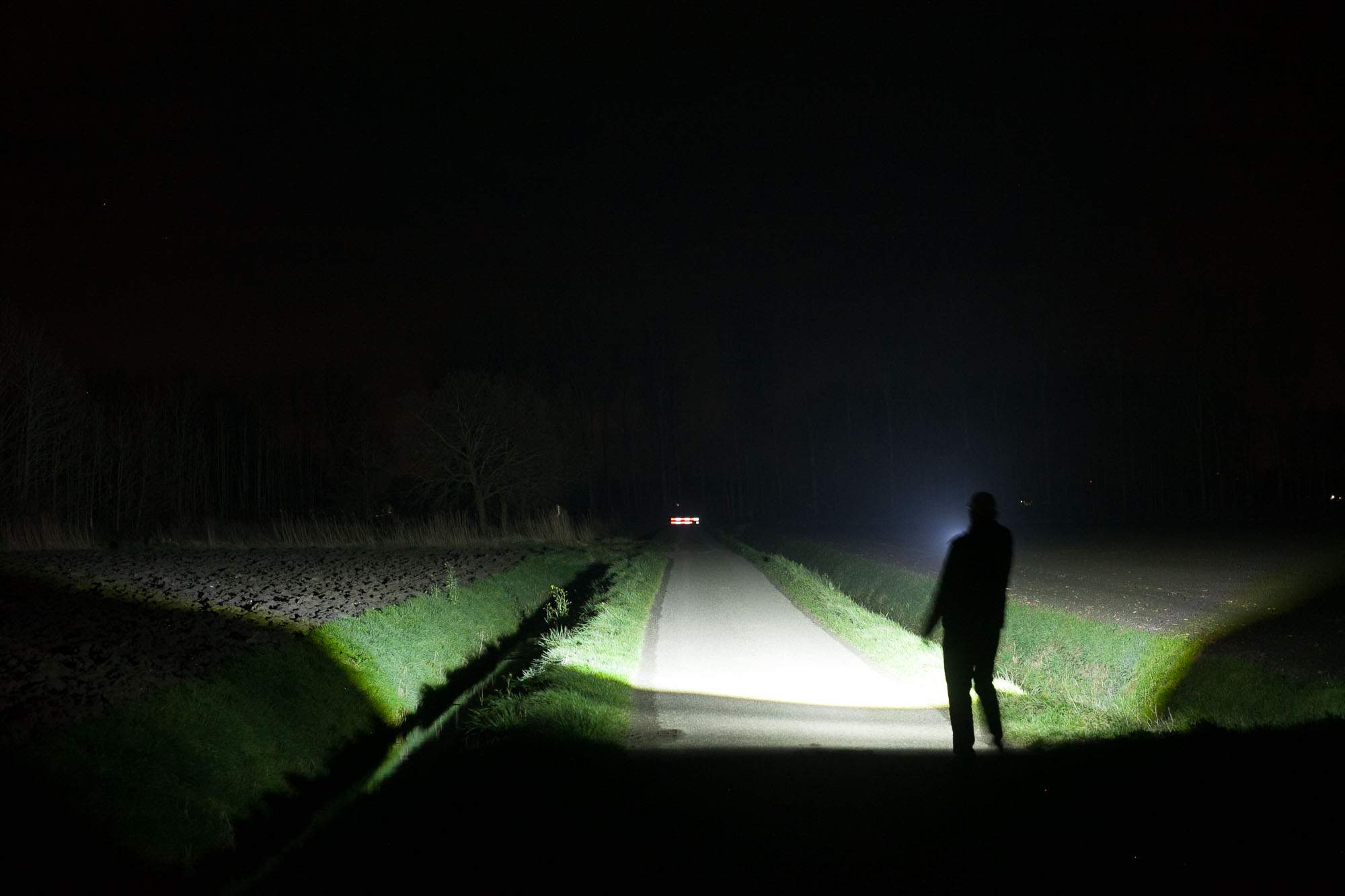
You see, the zoom feature doesn’t make much of a difference. In my opinion, they could have left out the Zoom feature altogether. It’s just another way to get water, dust, or dirt inside the flashlight.
Disclaimer: Nebo sent This flashlight to me for review at no cost. I have not been paid to review, nor have I been holding back on problems or defects.
Final Verdict
Pros
- Very bright at turn on
- USB-C charging
- Pretty decent build quality
- No glue was used on the bezel, so you can reach the COB LED easily
- Plenty of battery life in the lowest mode
- Includes a power bank feature
- Available in many countries around the globe
Cons
- The focus system has no real benefits (2x zoom doesn’t mean it zooms 2 times)
- To enter Turbo mode you must hold the switch pressed instead of a click
- UI: just check the UI section for this (too long to write here)
- Anodization seems a bit weak
- The highest modes aren’t well spaced and are too close in terms of runtimes
Explanation on star ratings:
1: Avoid: my phone flashlight would be a better choice – 2: Poor: significant defect or issues; almost unusable – 3: Average: some defects or issues; but still usable 4: Good: recommended (minor issues) – 5: Great: highly recommended

3.5 stars: ★★★⋆
This thing is crazy bright, and probably one of the brightest flashlights you can buy in a regular brick-and-mortar store. I measured over 12,000 lumens at turn on, and it’s a wall of light.
With the built-in power bank feature, you can charge your phone or any other device while out in the bush. That’s a nice feature for sure.
But I also found quite a few things that I’m not exactly pleased with, including the focus system, UI, mode spacing, and anodization.
If you don’t mind these things, and you want to buy the most powerful light you can get locally, the Nebo 12K might be it.
Nebo 12K discount code
Get 15% off your next Nebo purchase by using our unique 1Lumen discount code: 1lumen
1lumen selects and reviews products personally. We may earn affiliate commissions through our links, which help support our testing.